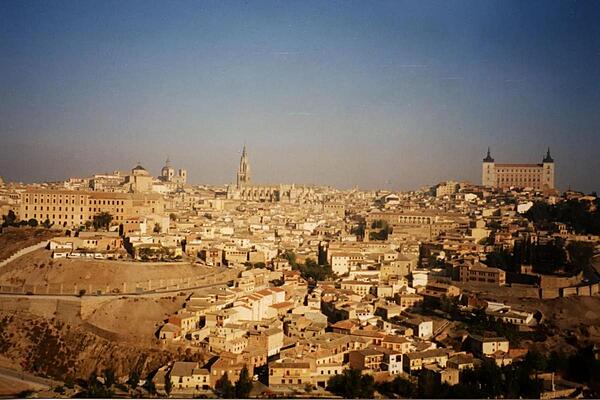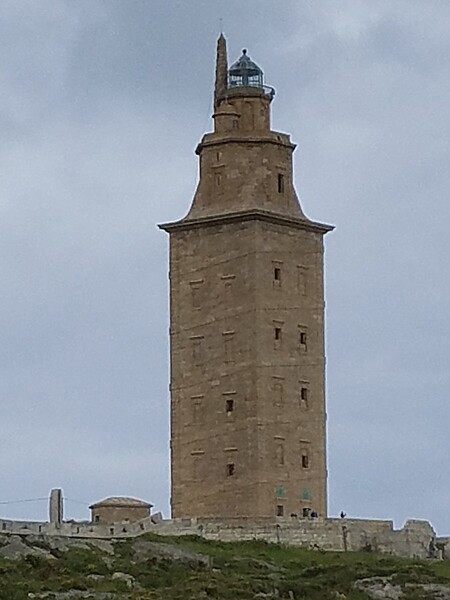
conventional long form: Kingdom of Spain
conventional short form: Spain
local long form: Reino de Espana
local short form: Espana
etymology: derivation of the name "Espana" is uncertain, but may come from the Phoenician term "span," related to the word "spy," meaning "to forge metals," so, "i-spn-ya" would mean "place where metals are forged"; the ancient Phoenicians long exploited the Iberian Peninsula for its mineral wealth
parliamentary constitutional monarchy
name: Madrid
geographic coordinates: 40 24 N, 3 41 W
time difference: UTC+1 (6 hours ahead of Washington, DC, during Standard Time)
daylight saving time: +1hr, begins last Sunday in March; ends last Sunday in October
time zone note: Spain has two time zones, including the Canary Islands (UTC 0)
etymology: the Romans named the original settlement "Matrice" after the river that ran through it; under Arab rule it became "Majerit," meaning "source of water"; in medieval Romance dialects (Mozarabic) it became "Matrit," which over time changed to "Madrid"
17 autonomous communities (comunidades autonomas, singular - comunidad autonoma) and 2 autonomous cities* (ciudades autonomas, singular - ciudad autonoma); Andalucia; Aragon; Asturias; Canarias (Canary Islands); Cantabria; Castilla-La Mancha; Castilla-Leon; Cataluna (Castilian), Catalunya (Catalan), Catalonha (Aranese) [Catalonia]; Ceuta*; Comunidad Valenciana (Castilian), Comunitat Valenciana (Valencian) [Valencian Community]; Extremadura; Galicia; Illes Baleares (Balearic Islands); La Rioja; Madrid; Melilla*; Murcia; Navarra (Castilian), Nafarroa (Basque) [Navarre]; Pais Vasco (Castilian), Euskadi (Basque) [Basque Country]
note: the autonomous cities of Ceuta and Melilla plus three small islands of Islas Chafarinas, Penon de Alhucemas, and Penon de Velez de la Gomera, administered directly by the Spanish central government, are all along the coast of Morocco and are collectively referred to as Places of Sovereignty (Plazas de Soberania)
1492; the Iberian peninsula was characterized by a variety of independent kingdoms prior to the Muslim occupation that began in the early 8th century A.D. and lasted nearly seven centuries; the small Christian redoubts of the north began the reconquest almost immediately, culminating in the seizure of Granada in 1492; this event completed the unification of several kingdoms and is traditionally considered the forging of present-day Spain
National Day (Hispanic Day), 12 October (1492); note - commemorates the arrival of COLUMBUS in the Americas
history: previous 1812; latest approved by the General Courts 31 October 1978, passed by referendum 6 December 1978, signed by the king 27 December 1978, effective 29 December 1978
amendments: proposed by the government, by the General Courts (the Congress or the Senate), or by the self-governing communities submitted through the government; passage requires three-fifths majority vote by both houses and passage by referendum if requested by one tenth of the members of either house; proposals disapproved by both houses are submitted to a joint committee, which submits an agreed upon text for another vote; passage requires two-thirds majority vote in Congress and simple majority vote in the Senate; amended 1992, 2011
civil law system with regional variations
accepts compulsory ICJ jurisdiction with reservations; accepts ICCt jurisdiction
citizenship by birth: no
citizenship by descent only: at least one parent must be a citizen of Spain
dual citizenship recognized: only with select Latin American countries
residency requirement for naturalization: 10 years for persons with no ties to Spain
18 years of age; universal
chief of state: King FELIPE VI (since 19 June 2014); Heir Apparent Princess LEONOR, Princess of Asturias (daughter of the monarch, born 31 October 2005)
head of government: President of the Government of Spain (prime minister-equivalent) Pedro SANCHEZ PEREZ-CASTEJON (since 2 June 2018); Vice President Nadia Maria CALVINO Santamaria (since 12 July 2021)
cabinet: Council of Ministers designated by the president
elections/appointments: the monarchy is hereditary; following legislative elections, the monarch usually proposes as president the leader of the majority party or coalition, who is then indirectly elected by the Congress of Deputies; election last held on 23 July 2023 (next to be held on 31 July 2027); vice president and Council of Ministers appointed by the president
election results: Congress of Deputies vote - NA
note: there is also a Council of State that is the supreme consultative organ of the government, but its recommendations are non-binding
description: bicameral General Courts or Las Cortes Generales consists of:
Senate or Senado (265 seats; 208 members directly elected in multi-seat constituencies by simple majority vote and 57 members indirectly elected by the legislatures of the autonomous communities; members serve 4-year terms)
Congress of Deputies or Congreso de los Diputados (350 seats; 348 members directly elected in 50 multi-seat constituencies by closed-list proportional representation vote, with a 3% threshold needed to gain a seat, and 2 directly elected from the North African Ceuta and Melilla enclaves by simple majority vote; members serve 4-year terms or until the government is dissolved)
elections:
Senate - last held on 23 July 2023 (next to be held no later than July 2027)
Congress of Deputies - last held on 23 July 2023 (next to be held no later than July 2027)
election results:
Senate - percent of vote by party - NA; seats by party - PP 120, PSOE 72, ERC 7, PNV 4, other 5; composition as of January 2024 - men 153, women 112; percent of women 42.3%
Congress of Deputies - percent of vote by party - PP 33.1%, PSOE 31.7%, Vox 12.4%, Sumar 12.3%, ERC 1.7%, Junts 1.6%, EH-Bildu 1.4%, PNV 1.1% other 4.7%; seats by party - PP 137, PSOE 121, Vox 33, Sumar 31, ERC 7, Junts 7, EH-Bildu 6, PNV 5, other 3; composition as of January 2024 - men 195, women 155, percent of women 44.3%; note - overall General Courts percent of women 42%
highest court(s): Supreme Court or Tribunal Supremo (consists of the court president and organized into the Civil Room, with a president and 9 judges; the Penal Room, with a president and 14 judges; the Administrative Room, with a president and 32 judges; the Social Room, with a president and 12 judges; and the Military Room, with a president and 7 judges); Constitutional Court or Tribunal Constitucional de Espana (consists of 12 judges)
judge selection and term of office: Supreme Court judges appointed by the monarch from candidates proposed by the General Council of the Judiciary Power, a 20-member governing board chaired by the monarch that includes presidential appointees, lawyers, and jurists confirmed by the National Assembly; judges can serve until age 70; Constitutional Court judges nominated by the National Assembly, executive branch, and the General Council of the Judiciary, and appointed by the monarch for 9-year terms
subordinate courts: National High Court; High Courts of Justice (in each of the autonomous communities); provincial courts; courts of first instance
Asturias Forum or FAC [Carmen MORIYON]
Basque Country Unite (Euskal Herria Bildu) or EH Bildu [Arnaldo OTEGI] (coalition of 4 Basque pro-independence parties)
Basque Nationalist Party or PNV or EAJ [Andoni ORTUZAR]
Canarian Coalition or CC [Fernando Clavijo BATLLE] (coalition of 5 parties)
Ciudadanos Party (Citizens Party) or Cs [Adrian Vazquez LAZARA]
Compromis - Compromise Coalition [Enric MORERA i Català]
Navarrese People's Union or UPN [Javier ESPARZA]
Together for Catalonia or Junts [Carles PUIGDEMONT]
People's Party or PP [Alberto Nunez FEIJOO]
Republican Left of Catalonia or ERC [Oriol JUNQUERAS]
Spanish Socialist Workers Party or PSOE [Pedro SANCHEZ]
Teruel Existe or TE [Tomas GUITARTE]
Unidas (Unite) or Sumar [Yolanda Diaz] (electoral coalition formed in March 2022) (formerly Unidas Podemos or UP)
Vox or VOX [Santiago ABASCAL]
ADB (nonregional member), AfDB (nonregional member), Arctic Council (observer), Australia Group, BCIE, BIS, CABEI, CAN (observer), CBSS (observer), CD, CE, CERN, EAPC, EBRD, ECB, EIB, EITI (implementing country), EMU, ESA, EU, FAO, FATF, IADB, IAEA, IBRD, ICAO, ICC (national committees), ICCt, ICRM, IDA, IEA, IFAD, IFC, IFRCS, IHO, ILO, IMF, IMO, IMSO, Interpol, IOC, IOM, IPU, ISO, ITSO, ITU, ITUC (NGOs), LAIA (observer), MIGA, NATO, NEA, NSG, OAS (observer), OECD, OPCW, OSCE, Pacific Alliance (observer), Paris Club, PCA, PIF (partner), Schengen Convention, SELEC (observer), SICA (observer), UN, UNCTAD, UNESCO, UNHCR, UNIDO, UNIFIL, Union Latina, UNOCI, UNOOSA, UNRWA, UNWTO, UPU, Wassenaar Arrangement, WCO, WHO, WIPO, WMO, WTO, ZC
chief of mission: Ambassador Ángeles MORENO Bau (since 27 February 2024)
chancery: 2375 Pennsylvania Avenue NW, Washington, DC 20037
telephone: [1] (202) 452-0100
FAX: [1] (202) 833-5670
email address and website:
emb.washington@maec.es
https://www.exteriores.gob.es/Embajadas/washington/en/Paginas/index.aspx
consulate(s) general: Boston, Chicago, Houston, Los Angeles, Miami, New York, San Francisco, San Juan (Puerto Rico)
chief of mission: Ambassador Julissa REYNOSO (since 2 February 2022); note - also accredited to Andorra
embassy: Calle de Serrano, 75, 28006 Madrid
mailing address: 8500 Madrid Place, Washington DC 20521-8500
telephone: [34] (91) 587-2200
FAX: [34] (91) 587-2303
email address and website:
askACS@state.gov
https://es.usembassy.gov/
consulate(s) general: Barcelona
three horizontal bands of red (top), yellow (double width), and red with the national coat of arms on the hoist side of the yellow band; the coat of arms is quartered to display the emblems of the traditional kingdoms of Spain (clockwise from upper left, Castile, Leon, Navarre, and Aragon) while Granada is represented by the stylized pomegranate at the bottom of the shield; the arms are framed by two columns representing the Pillars of Hercules, which are the two promontories (Gibraltar and Ceuta) on either side of the eastern end of the Strait of Gibraltar; the red scroll across the two columns bears the imperial motto of "Plus Ultra" (further beyond) referring to Spanish lands beyond Europe; the triband arrangement with the center stripe twice the width of the outer dates to the 18th century
note: the red and yellow colors are related to those of the oldest Spanish kingdoms: Aragon, Castile, Leon, and Navarre
Pillars of Hercules; national colors: red, yellow
name: "Himno Nacional Espanol" (National Anthem of Spain)
lyrics/music: no lyrics/unknown
note: officially in use between 1770 and 1931, restored in 1939; the Spanish anthem is the first anthem to be officially adopted, but it has no lyrics; in the years prior to 1931 it became known as "Marcha Real" (The Royal March); it first appeared in a 1761 military bugle call book and was replaced by "Himno de Riego" in the years between 1931 and 1939; the long version of the anthem is used for the king, while the short version is used for the prince, prime minister, and occasions such as sporting events
total World Heritage Sites: 50 (44 cultural, 4 natural, 2 mixed)
selected World Heritage Site locales: Cave of Altamira and Paleolithic Cave Art of Northern Spain (c);  (c); Santiago de Compostela (Old Town) (c);
(c); Santiago de Compostela (Old Town) (c);  (c); Archaeological Ensemble of Mérida (c);
(c); Archaeological Ensemble of Mérida (c);  (c); Doñana National Park (n); Pyrénées - Mont Perdu (m); Alhambra, Generalife, and Albayzín in Granada (c); Old City of Salamanca (c); Teide National Park (n); Historic Walled Town of Cuenca (c); Old Town of Segovia and its Aqueduct (c); Historic Cordoba (c); El Escorial (c)
(c); Doñana National Park (n); Pyrénées - Mont Perdu (m); Alhambra, Generalife, and Albayzín in Granada (c); Old City of Salamanca (c); Teide National Park (n); Historic Walled Town of Cuenca (c); Old Town of Segovia and its Aqueduct (c); Historic Cordoba (c); El Escorial (c)
NOTE: The information regarding Spain on this page is re-published from the 2024 World Fact Book of the United States Central Intelligence Agency and other sources. No claims are made regarding the accuracy of Spain 2024 information contained here. All suggestions for corrections of any errors about Spain 2024 should be addressed to the CIA or the source cited on each page.
This page was last modified 04 May 24, Copyright © 2024 ITA all rights reserved.